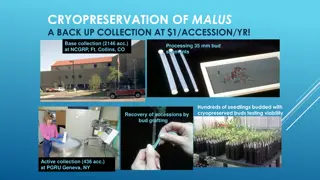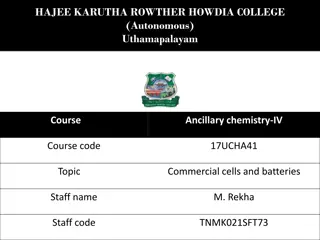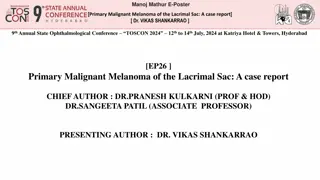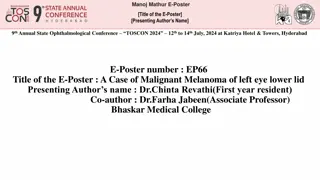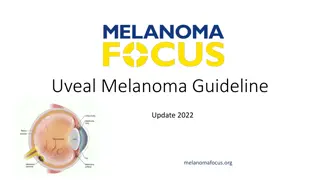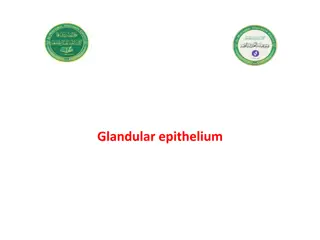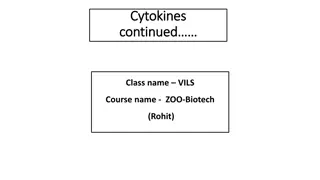Understanding Melanoma Cells Cryopreservation for Biomedical Studies
Explore the culture and cryopreservation techniques of melanoma cells, alongside a comparison with melanocytes. Understand the stages of melanoma tumors and the damaging factors during cell freezing. Learn about cryoprotectants and the process of cryopreservation in preserving biological materials.
Download Presentation

Please find below an Image/Link to download the presentation.
The content on the website is provided AS IS for your information and personal use only. It may not be sold, licensed, or shared on other websites without obtaining consent from the author. Download presentation by click this link. If you encounter any issues during the download, it is possible that the publisher has removed the file from their server.
E N D
Presentation Transcript
Culture and cryopreservation of melanoma cells for PALS measurements biomedical study Krak w, 13 September 2018 Agnieszka Kami ska, MSc. Eng. Faculty of Physics, Astronomy and Applied Computer Science Jagiellonian University 3rd Symposium on Positron Emission Tomography, Krak w 2018
Characteristic of melanoma tumor Stages: Stage 0: the cancer is in the outermost layer of skin Stage 1: the cancer is less than 1 mm thick Stage 2: the cancer is 1-4 mm thick Stage 3: the cancer has spread to lymph nodes Stage 4: the cancer has spread to distant lymph nodes or organs https://www.medicalnewstoday.com/articles/154322.php https://www.verywellhealth.com/melanoma-staging-what-it-means-and-reveals- 3010755
Culture of melanocytes and melanoma cells Culture conditions: 5% CO2 37 C HEMa-LP (melanocytes) WM115 WM266 (metastatic) (primary melanoma) RPMI (with L-glutamine) 10% FBS RPMI (with L-glutamine) 10% FBS medium 254 supplemented with HMGS (Human Melanocyte Growth Supplement) 0.5% FBS Penicyllin/Streptomycin
Melanoma cells vs. melanocytes a) irregular shape reduced amount of cytoplasm bigger/multiplied nuclei higher level of cortactin VEGF b) E-cadherin N-cadherin differential expression of miRNA Melanocytes (a) and melanoma cells (b), images by E. Kubicz
Freezing of the cells damaging factors Thermal shock Formation of ice crystals Dehydration Increased salt concentration Osmotic shock
Cryopreservation the technique of freezing cells and tissues at very low temperatures (-196 C) which requires the use of a cryoprotective agent. biological material retains genetically stable stopping the biological activity minimaizing ice crystals formation
Cryoprotectants Dimethyl sulfoxide Trehalose 1,2 - Propanediol
Lyiophilization Liquid Solid Gas https://courses.lumenlearning.com/cheminter/chapter/phase-diagram-for-water/
Lyiophilization Sample preparation Primary drying Secondary drying Final product Freezing
Cryopreservation Freezing media: PBS (Ca2+, Mg2+free) PBS (Ca2+, Mg2+free) + 10% DMSO RPMI+20% FBS+10% DMSO 1.5M PROH+0.5M Trehalose 0.25M Trehalose
Cryoprotectant - Trehalose Disaccharide of glucose (342 Da) , -1, 1-glycosidic bond Bioprotective action of trehalose - hypothesis: 1. Water replacement 2. Rearrengement of water molecules 3. Transition to glassy state
Conclusions The preservation of cells is an extremely important aspect of cell culture To ensure high viability of cells (>90%) it is very important to choose appropriate cryoprotectant and handling techniques. Supplementation of standard cryoprotective medium with trehalose improving post-thaw cell viability and metabolism. Lyophilization of cultured cells allows to performing Positron Annihilation Lifetime Spectroscopy (PALS) measurements for several hours without cell damage.






